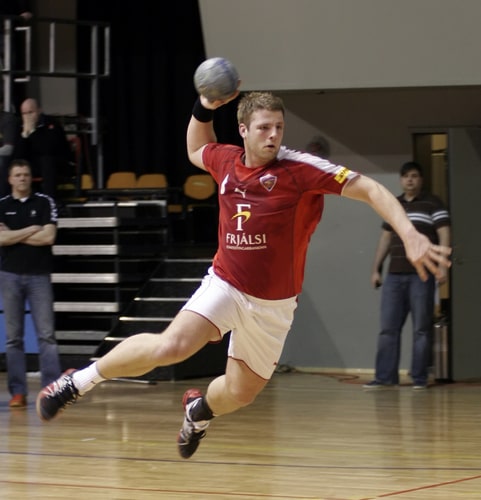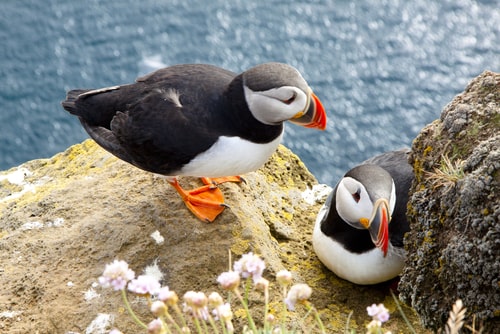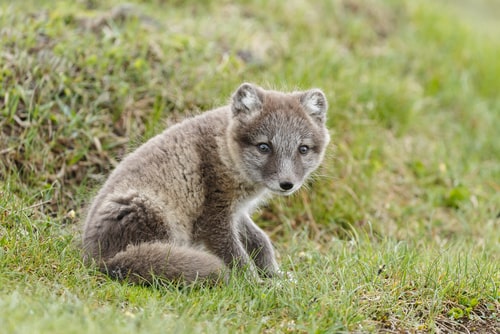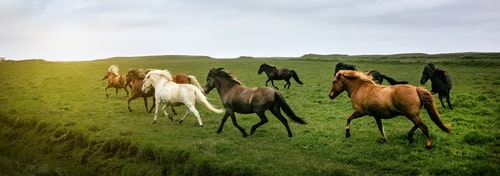Last updated on May 15th, 2022
Culture
39. Family names are not used as surnames. Icelanders carry patronymic surnames based on the first name of their father (e.g. Elisabet Jônsdôttir means Elisabet, Jôn’s daughter).
40. Icelanders call each other by their given names, even the president. The telephone directory is even listed alphabetically by first name rather than surname. All new first names never used before in Iceland must be approved by the Icelandic Naming Committee.
41. The cornerstone of Icelandic culture is their language and literary tradition dating back to their ancient Sagas. This tradition still thrives in Iceland today where authors publish more books per capita than anywhere else in the world. Almost everyone writes.
42. Iceland has no standing army, but the Coast Guard maintains the Iceland Air Defense System and patrols coastal waters. The police forces carry no guns.
43. Iceland’s people watch more movies at the cinema than any other country. Icelanders average five films each per year. That is twice the Western European average and five times that of the Japanese.

44. The national sport of Iceland is handball. The Icelandic Men’s Team ranked among the top 12 in the world. The main traditional sport is called Glima which is a form of wrestling thought to be from medieval times. Football (soccer) is the most popular team sport.
45. Icelanders’ festivals and holidays celebrate church or ancient Norse traditions. These include Bóndadajur (“husband’s day”), and Thorrablot, a midwinter celebration based on an ancient pagan sacrificial winter fest. Jónsmessa celebrates Midsummer Night.
46. As many as 80 percent of the population of Icelanders still believe in the existence of elves. Even today some roads have been rerouted so as not to disturb rocks or other places said to be the homes of elves.
47. Instead of Santa, the thirteen Yule Lads help children celebrate Icelandic Christmases.
Icelandic food facts
48. Distinctively Icelandic foods include fish, skyr ( a yogury-like dairy product), hanhikjöt (smoked lamb), sviŏ (singed sheep’s head),hákari (cured shark), and harŏfiskur (dried fish pieces eaten with butter or coleslaw for a snack).

49. Puffin is considered a local delicacy. It is prepared through broiling and served shredded. Raw puffin heart is considered a delicacy. (Puffins are listed by the IUCN as an endangered animal, so keep that in mind before you dine.)
50. Cereal, pancakes, fruit and coffee is the traditional breakfast fare while lunch may take the form of a smŏrgásbord. Dinner is usually the main meal of the day, with lamb or fish served as the main course.
51. Seafood is key to most Icelanders’ cooking, particularly haddock and cod. They also enjoy herring, salmon and halibut. It is prepared either dried, smoked, pickled or boiled.
52. Lamb is by far the most commonly eaten meat and is served either smoke-cured( hanhikjöt) or salt-preserved (saltjöt). Side dishes include mashed or boiled potatoes, green beans and rye bread.
53. Coffee is a popular beverage for every meal and an afternoon treat. Coca-Cola is consumed at one of the highest per capita rates in the world. The native alcoholic beverage is Brennivin (“burnt or distilled wine”).
54. Famous for its whale meat, Iceland is one of the few places worldwide where it is possible to eat Minke whale. It is eaten more by tourists than the locals.
55. Iceland also enjoys some local cuisine that visitors may find off-putting. These include hákari (putrescent shark meat), súrsaöir hrútspungar (boiled and cured ram’s testicles), and lundabaggi (sheep’s loins cured in lactic acid).
Tourism
56. Conditions are excellent in Iceland for skiing, snowboarding, rock and ice climbing as well as mountain climbing, hiking, fishing, cycling and ski touring.
57. The beautiful therapeutic Blue Lagoon spa is fed warm water from the nearby geothermal plant. Daub in white silica mud and come out silky smooth and relaxed. Book your spot ahead of time, though.
58. The pink and red sands of Rauðasandur beach in the Westfjords are backed by a huge serene lagoon. Watch for seals and walk the path to the nearby bird cliffs.
59. A fantastic destination for hiking is the wilderness area of Hornstrandir in the Westfjords, with its craggy mountains, sea cliffs and plunging waterfalls. See seals, Arctic foxes, whales and a variety of bird life.
60. Near the Bjargtangar Lighthouse are the famous Látrabjarg bird cliffs, so named for the mobs of nesting seabirds who make them their home each summer. Puffins, guillemots, razorbills, cormorants, gulls, fulmars and kittiwakes nest here from June to mid-August.
61. Take a boat trip or scout for seals through the Jökulsárlón glacier lagoon, beside the Ring Road between Höfn and Skaftafell. See the spectacular icebergs drift and admire all the ice sculptures striped with layers of volcanic ash. The lagoon is only 80 years old and still expanding in size.
62. Skaftafell is the jewel in the crown of Vatnajökull National Park, the country’s favorite wilderness area. It has a breathtaking collection of glaciers and peaks, waterfalls, and rivers, and twisted birch woods.
63. Snæfellsjökull National Park includes lava tubes, protected lava fields which are home to native Icelandic fauna, and prime coastal bird, and whale-watching spots. The park is full of hiking trails, and during nice weather it is possible to visit the glacier with a tour or guide.
64. Gulfoss, also known as the Golden Circle, is Iceland’s most famous waterfall with its double cascade pushing up magnificent walls of spray as it thunders down a rocky ravine. The mist is full of shimmering rainbows on sunny days. Above the falls is a small cafe and shop.
65. Þingvellir National Park is a UNESCO World Heritage site east of Reykjavík. Not only is it the original site of the longest running parliament in the world, it’s also where the North-American and European continental shelf plates are being torn apart. A path runs along the fault.
Animal and Plant Life

66. The only mammal native to Iceland is the Arctic fox. Settlers brought over all others today including the Icelandic sheep, cattle, goats, chickens, Icelandic horse and Icelandic Sheepdog are all descendants of those animals. Wild ones include mink, rabbits, rats and reindeer.
67. Only a fourth of the island has any vegetation and only one percent of the soil is arable. The once extensive forests are depleted and now almost non-existent. The remaining trees are mostly birch, spruce, aspen and willow.
68. The number of insect species are low compared to other countries. Mosquitoes do not exist in Iceland.
69. Polar bears occasionally arrive on an ice flow from Greenland but do not live in Iceland.

70. The Icelandic horse has two additional gaits more than any other breed.
Random Facts
71. The Icelandic government has banned prostitution in 2009 and banned strip clubs in 2010.
72. Despite its name, Iceland’s surface is only ten percent ice and it has surprisingly mild winters due to the warming effect of the Atlantic Gulf Stream. Icelanders joke that they should be Greenland and Greenland should be Iceland.
73. It is illegal to own a pet lizard, snake or turtle in Iceland. There are no reptiles or amphibians there.
74. The Phallological Museum is one of the nation’s most unusual attractions. It houses the world’s largest collection of penises and penile parts, including 55 whale penises.
75. The annual Arctic Open Golf Tournament in Akureyri has a midnight tee time during the midnight sun and attracts participants from around the world.
76. The most common female name in Iceland – “Hekla,” is also the name of one of its most active volcanoes. It is 1,491 m in height and it is in south of Iceland.
77. This land of long winter nights and short summer days is shaped by the four basic elements – earth, wind, fire and water – in a dramatic way that make it an adventure playground.
Iceland – country at a glance
| Independence | 1 December 1918 |
|---|---|
| Capital City | Reykjavík 64°08′N 21°56′W |
| Largest city | Reykjavík 64°08′N 21°56′W |
| Total area | total : 103,000 sq km land: 100,250 sq km water: 2,750 sq km (slightly smaller than Pennsylvania; about the same size as Kentucky) |
| Population | 364,036 (2024 est.) |
| Currency | Icelandic króna (ISK) |
| Continent | Europe |
| Government type | parliamentary republic |
| President | Halla Tómasdóttir |
| Prime Minister | Kristrún Frostadóttir |
| National anthem | "Lofsongur" (Song of Praise) |
| National Bird symbol | Gyrfalcon |
| National colors | blue, white, red |
| Official Languages | Icelandic |
| Borders | Sweden, Norway and Russia |
| Coastline | 4,970 km |
| Religion | Lutheran 73.8%, Orthodox 1.1%, other or none 25.1% (2014 est.) |
| Life expectancy at birth | 84 years (2024 est.) |
| Agricultural land | 18.7% |
| Climate | temperate; moderated by North Atlantic Current; mild, windy winters; damp, cool summers |
| Terrain | mostly plateau interspersed with mountain peaks, icefields; coast deeply indented by bays and fiords |
| Highest point | Hvannadalshnukur (at Vatnajokull Glacier) 2,110 m |
| Lowest point | Atlantic Ocean 0 m |
| Mean elevation | 557 m |
| Industries | tourism, fish processing; aluminum smelting;; geothermal power, hydropower; medical/pharmaceutical products |
| Exports | $13.71 billion (2023 est.) aluminum and aluminum products, fish products, aircraft, iron alloys, animal meal (2019) |
| Imports | $13.532 billion (2023 est.) refined petroleum, aluminum oxide, carbon/graphite electronics, cars, packaged medicines (2019) |
| GDP - per capita (PPP) | $67,300 (2023 est.) |
| Birth rate | 12.6 births/1,000 population (2024 est.) |
| Death rate | 6.6 deaths/1,000 population (2024 est.) |
| Sex ratio | 1 male(s)/female (2024 est.) |
| Time Zone | WET (UTC+0) |
| Internet country code | .is |
| Calling Code | +354 |
| Drives on the | Right |
| Table last updated | February 27, 2025 |
